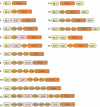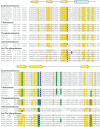Structural classification of bacterial response regulators: diversity of output domains and domain combinations
- PMID: 16740923
- PMCID: PMC1482966
- DOI: 10.1128/JB.01887-05
Structural classification of bacterial response regulators: diversity of output domains and domain combinations
Abstract
CheY-like phosphoacceptor (or receiver [REC]) domain is a common module in a variety of response regulators of the bacterial signal transduction systems. In this work, 4,610 response regulators, encoded in complete genomes of 200 bacterial and archaeal species, were identified and classified by their domain architectures. Previously uncharacterized output domains were analyzed and, in some cases, assigned to known domain families. Transcriptional regulators of the OmpR, NarL, and NtrC families were found to comprise almost 60% of all response regulators; transcriptional regulators with other DNA-binding domains (LytTR, AraC, Spo0A, Fis, YcbB, RpoE, and MerR) account for an additional 6%. The remaining one-third is represented by the stand-alone REC domain (approximately 14%) and its combinations with a variety of enzymatic (GGDEF, EAL, HD-GYP, CheB, CheC, PP2C, and HisK), RNA-binding (ANTAR and CsrA), protein- or ligand-binding (PAS, GAF, TPR, CAP_ED, and HPt) domains, or newly described domains of unknown function. The diversity of domain architectures and the abundance of alternative domain combinations suggest that fusions between the REC domain and various output domains is a widespread evolutionary mechanism that allows bacterial cells to regulate transcription, enzyme activity, and/or protein-protein interactions in response to environmental challenges. The complete list of response regulators encoded in each of the 200 analyzed genomes is available online at http://www.ncbi.nlm.nih.gov/Complete_Genomes/RRcensus.html.
Figures




Comment in
-
Census of prokaryotic senses.J Bacteriol. 2006 Jun;188(12):4165-8. doi: 10.1128/JB.00311-06. J Bacteriol. 2006. PMID: 16740922 Free PMC article. No abstract available.
References
-
- Aldridge, P., and U. Jenal. 1999. Cell cycle-dependent degradation of a flagellar motor component requires a novel-type response regulator. Mol. Microbiol. 32:379-391. - PubMed
-
- Aldridge, P., R. Paul, P. Goymer, P. Rainey, and U. Jenal. 2003. Role of the GGDEF regulator PleD in polar development of Caulobacter crescentus. Mol. Microbiol. 47:1695-1708. - PubMed
-
- Amikam, D., and M. Y. Galperin. 2006. PilZ domain is part of the bacterial c-di-GMP binding protein. Bioinformatics 22:3-6. - PubMed
-
- Anand, G. S., P. N. Goudreau, and A. M. Stock. 1998. Activation of methylesterase CheB: evidence of a dual role for the regulatory domain. Biochemistry 37:14038-14047. - PubMed
Publication types
MeSH terms
Substances
Grants and funding
LinkOut - more resources
Full Text Sources
Molecular Biology Databases
Miscellaneous

